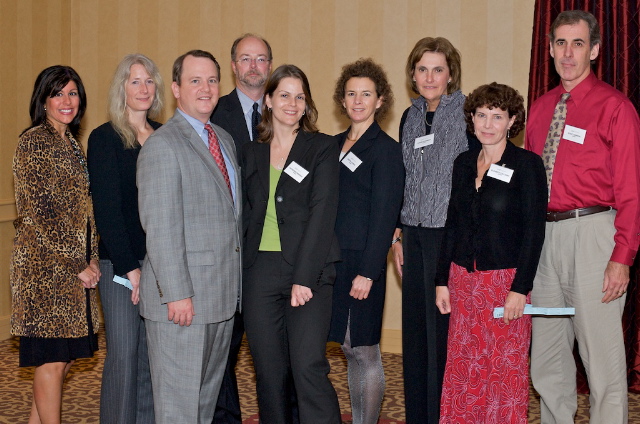|
The American Academy Of Pediatrics
The American Academy of Pediatrics (AAP) is an American professional association of pediatricians, headquartered in Itasca, Illinois. It maintains its Department of Federal Affairs office in Washington, D.C. Background The Academy was founded in 1930 by 35 pediatricians to address pediatric healthcare standards. It has 67,000 members in primary care and sub-specialist areas. Qualified pediatricians can become fellows (FAAP). The Academy runs continuing medical education (CME) programs for pediatricians and sub-specialists. The Academy is divided into 14 departments and 26 divisions that assist with carrying out its mission. Publications It has the largest pediatric publishing program in the world, with more than 300 titles for consumers and over 500 titles for physicians and other healthcare professionals. These publications include electronic products, professional references/textbooks, practice management publications, patient education materials, and parenting books. The ... [...More Info...] [...Related Items...] OR: [Wikipedia] [Google] [Baidu] |
Professional Association
A professional association (also called a professional body, professional organization, or professional society) usually seeks to advocacy, further a particular profession, the interests of individuals and organisations engaged in that profession, and the public interest. In the United States, such an association is typically a nonprofit organization, nonprofit business league for tax purposes. Roles The roles of professional associations have been variously defined: "A group, of people in a learned occupation who are entrusted with maintaining control or oversight of the legitimate practice of the occupation;" also a body acting "to safeguard the public interest;" organizations which "represent the interest of the professional practitioners," and so "act to maintain their own privileged and powerful position as a controlling body." Professional associations are ill defined although often have commonality in purpose and activities. In the UK, the Science Council defines a profess ... [...More Info...] [...Related Items...] OR: [Wikipedia] [Google] [Baidu] |
The New York Times
''The New York Times'' (''the Times'', ''NYT'', or the Gray Lady) is a daily newspaper based in New York City with a worldwide readership reported in 2020 to comprise a declining 840,000 paid print subscribers, and a growing 6 million paid digital subscribers. It also is a producer of popular podcasts such as '' The Daily''. Founded in 1851 by Henry Jarvis Raymond and George Jones, it was initially published by Raymond, Jones & Company. The ''Times'' has won 132 Pulitzer Prizes, the most of any newspaper, and has long been regarded as a national " newspaper of record". For print it is ranked 18th in the world by circulation and 3rd in the U.S. The paper is owned by the New York Times Company, which is publicly traded. It has been governed by the Sulzberger family since 1896, through a dual-class share structure after its shares became publicly traded. A. G. Sulzberger, the paper's publisher and the company's chairman, is the fifth generation of the family to head the pa ... [...More Info...] [...Related Items...] OR: [Wikipedia] [Google] [Baidu] |
Royal College Of Obstetricians And Gynaecologists
The Royal College of Obstetricians and Gynaecologists (RCOG) is a professional association based in London, United Kingdom. Its members, including people with and without medical degrees, work in the field of obstetrics and gynaecology, that is, pregnancy, childbirth, and female sexual and reproductive health. The college has over 16,000 members in over 100 countries with nearly 50% of those residing outside the British Isles. Her Royal Highness the Princess of Wales became the RCOG's patron in 2018. The college's primary object is given as "The encouragement of the study and the advancement of the science and practice of obstetrics and gynaecology", although its governing documents impose no specific restrictions on its operation. Its present offices are based in London Bridge. Previously, the offices were located near Regent's Park in Central London. History The British College of Obstetricians and Gynaecologists was founded in September 1929 by Professor William Blair-Bell ... [...More Info...] [...Related Items...] OR: [Wikipedia] [Google] [Baidu] |
Female Genital Cutting
Female genital mutilation (FGM), also known as female genital cutting, female genital mutilation/cutting (FGM/C) and female circumcision, is the ritual cutting or removal of some or all of the external female genitalia. The practice is found in some countries of Africa, Asia and the Middle East, and within communities abroad from countries in which FGM is common. UNICEF estimated, in 2016, that 200 million women in 30 countries—Indonesia, Iraq, Yemen, and 27 African countries including Egypt—had been subjected to one or more types of FGM. Typically carried out by a traditional circumciser using a blade, FGM is conducted from days after birth to puberty and beyond. In half of the countries for which national statistics are available, most girls are cut before the age of five. Procedures differ according to the country or ethnic group. They include removal of the clitoral hood (type 1-a) and clitoral glans (1-b); removal of the inner labia; and removal of the inner and ou ... [...More Info...] [...Related Items...] OR: [Wikipedia] [Google] [Baidu] |
Circumcision Controversies
Male circumcision has been a subject of controversy for a number of reasons including religious, ethical, sexual, and medical. During the late 19th and early 20th centuries, the primary justification for circumcision was to prevent masturbation and intentionally reduce male sexual pleasure, which was believed to cause a wide range of medical problems. Modern proponents say that circumcision reduces the risks of a range of infections and diseases, and confers sexual benefits. By contrast, some opponents, particularly of routine neonatal circumcision, question its utility and effectiveness in preventing such diseases, and object to subjecting newborn males, without their consent, to a procedure they consider to have dubious and nonessential benefits, significant risks, and a potentially negative impact on general health and later sexual enjoyment, as well as violating their human rights. In Classical and Hellenistic civilization, Ancient Greeks and Romans posed great value on t ... [...More Info...] [...Related Items...] OR: [Wikipedia] [Google] [Baidu] |
Age Of Consent
The age of consent is the age at which a person is considered to be legally competent to consent to sexual acts. Consequently, an adult who engages in sexual activity with a person younger than the age of consent is unable to legally claim that the sexual activity was consensual, and such sexual activity may be considered child sexual abuse or statutory rape. The person below the minimum age is considered the victim, and their sex partner the offender, although some jurisdictions provide exceptions through " Romeo and Juliet laws" if one or both participants are underage, and are close in age. The term ''age of consent'' typically does not appear in legal statutes. Generally, a law will establish the age below which it is illegal to engage in sexual activity with that person. It has sometimes been used with other meanings, such as the age at which a person becomes competent to consent to marriage, but consent to sexual activity is the meaning now generally understood. It sho ... [...More Info...] [...Related Items...] OR: [Wikipedia] [Google] [Baidu] |
Bodily Integrity
Bodily integrity is the inviolability of the physical body and emphasizes the importance of personal autonomy, self-ownership, and self-determination of human beings over their own bodies. In the field of human rights, violation of the bodily integrity of another is regarded as an unethical infringement, intrusive, and possibly criminal.Communication Technology And Social Change Carolyn A. Lin, David J. Atkin – 2007 Government and law Ireland In the , bodily integrity has been recognised by the courts as an[...More Info...] [...Related Items...] OR: [Wikipedia] [Google] [Baidu] |
Children's Rights
Children's rights are a subset of human rights with particular attention to the rights of special protection and care afforded to minors."Children's Rights" , Amnesty International. Retrieved 2/23/08. The 1989 (CRC) defines a child as "any human being below the age of eighteen years, unless under the law applicable to the child, is attained earlier." [...More Info...] [...Related Items...] OR: [Wikipedia] [Google] [Baidu] |
Non-violence
Nonviolence is the personal practice of not causing harm to others under any condition. It may come from the belief that hurting people, animals and/or the environment is unnecessary to achieve an outcome and it may refer to a general philosophy of abstention from violence. It may be based on moral, religious or spiritual principles, or the reasons for it may be strategic or pragmatic. Failure to distinguish between the two types of nonviolent approaches can lead to distortion in the concept's meaning and effectiveness, which can subsequently result in confusion among the audience. Although both principled and pragmatic nonviolent approaches preach for nonviolence, they may have distinct motives, goals, philosophies, and techniques. However, rather than debating the best practice between the two approaches, both can indicate alternative paths for those who do not want to use violence. These forms of nonviolence approaches (pragmatic and principled) will be discussed in the later ... [...More Info...] [...Related Items...] OR: [Wikipedia] [Google] [Baidu] |
Cultural Bias
Cultural bias is the phenomenon of interpreting and judging phenomena by standards inherent to one's own culture. The phenomenon is sometimes considered a problem central to social and human sciences, such as economics, psychology, anthropology, and sociology. Some practitioners of the aforementioned fields have attempted to develop methods and theories to compensate for or eliminate cultural bias. Cultural bias occurs when people of a culture make assumptions about conventions, including conventions of language, notation, proof and evidence. They are then accused of mistaking these assumptions for laws of logic or nature. Numerous such biases exist, concerning cultural norms for color, mate selection, concepts of justice, linguistic and logical validity, the acceptability of evidence, and taboos. Psychology Cultural bias has no ''a priori'' definition. Instead, its presence is inferred from differential performance of socioracial (e.g., Blacks, Whites), ethnic (e.g., Latinos/L ... [...More Info...] [...Related Items...] OR: [Wikipedia] [Google] [Baidu] |
Northern Europe
The northern region of Europe has several definitions. A restrictive definition may describe Northern Europe as being roughly north of the southern coast of the Baltic Sea, which is about 54th parallel north, 54°N, or may be based on other geographical factors such as climate and ecology. Climate The climate is mainly Oceanic climate (Cfb), Humid continental climate (Dfb), Subarctic climate (Dfc and Dsc) and Tundra (ET). Geography Northern Europe might be defined roughly to include some or all of the following areas: British Isles, Fennoscandia, the peninsula of Jutland, the Baltic region, Baltic plain that lies to the east and the many islands that lie offshore from mainland Northern Europe and the main European continent. In some cases, Greenland is also included, although it is only politically European, comprising part of the Kingdom of Denmark, and not considered to be geographically in Europe. The area is partly mountainous, including the northern volcanic islands ... [...More Info...] [...Related Items...] OR: [Wikipedia] [Google] [Baidu] |
Journal Of Medical Ethics
The ''Journal of Medical Ethics'' is a monthly peer-reviewed academic journal covering the field of bioethics that was established in 1975. According to the ''Journal Citation Reports'', the journal has a 2019 impact factor of 2.021, ranking it fourth out of 16 journals in the category "Medical Ethics" and 11th out of 55 journals in the category "Ethics". Editors-in-chief The editor-in-chief is John McMillan (University of Otago). Previous editors have been: Julian Savulescu (University of Oxford) (2011–2018 and 2001–2004), Søren Holm (Cardiff University) and John Harris (University of Manchester, (jointly, 2004–2011), Raanan Gillon (Imperial College London, 1980–2001), and Alastair Campbell (University of Edinburgh, 1975–1980, founding editor). See also *List of ethics journals This is a list of peer-reviewed, academic journals in the field of ethics. ''Note'': there are many important academic magazines that are not true peer-reviewed journals. They are not list ... [...More Info...] [...Related Items...] OR: [Wikipedia] [Google] [Baidu] |

.png)

_2.jpg)



